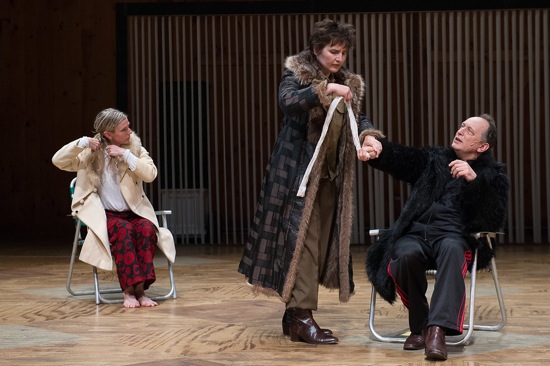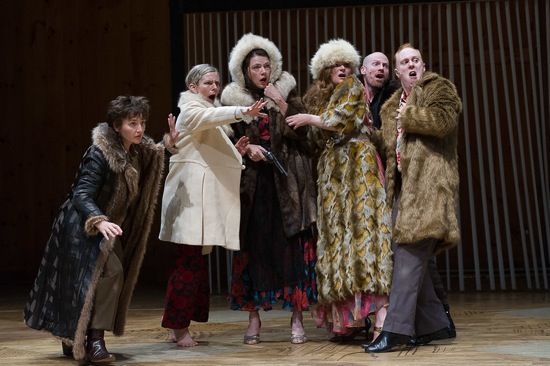
Aghast: Big Dance Theater in Alan Smithee Directed This Play: Triple Feature. (L to R): Cynthia Hopkins, Elizabeth DeMent, Tymberly Canale, Kourtney Rutherford, Aaron Mattocks, and Chris Giarmo. Photo: Christopher Duggan
Every time I see a work by Annie-B Parson and Paul Lazar of Big Dance Theater, I wish I could’ve been a fly on the wall while they were dreaming it up (although, since the collaborators are married, brainstorming gusts may happen erratically, at any hour of the day or night). Their constructions are so intricately layered, their often highly dissimilar ingredients stirred together so startlingly that you could wonder whether the two might some day conflate, say, the trial of Joan of Arc with a small-town bake sale in 1930s America. And bring it off with distinction.
Sometimes their enthralling works focus primarily on deconstructing one source—perhaps mixing into the performance the process of creating it, along with other pungent, possibly anachronistic elements. That was true of, for instance, of Another Telepathic Thing (2000), which dug into Mark Twain’s story “The Mysterious Stranger” and The Supernatural Wife (2011), which flowed erratically along the plotline of Euripedes’ Alcestis.
In other productions by Parson and Lazar, sources that you might well see as disparate receive almost equal status. That pretty much happened in The Other Here (2007) in which a text drawn from a conference of life insurance salesmen invaded elements from two stories by the Okinawan writer Masuji Ibuse. It happens too in Alan Smithee Directed This Play:Triple Feature, which premiered in Lyon, France in 2014, in New York during the Brooklyn Academy of Music’s 2014 Next Wave Festival, and most recently appeared at Jacob’s Pillow.
This new work mingles two movies, Dr. Zhivago (1965) and Terms of Endearment (1983). It’s as if these have been spun in separate creative centrifuges and then poured judiciously together—now a little of this, now a little of that. Then for Gallic spice (or deeper motives), Parson and Lazar project fragmented scenes from Jean-Pierre Melville’s 1970 heist film, Le Cercle Rouge (but in black and white); all of a sudden a mustachioed Alain Delon is helping an escaped convict (Gian Maria Volonté) out of the trunk of a car.
This Big Dance Theater work abounds in mysteries, beginning with its title. “Alan Smithee” is an iconic pseudonym adopted by Hollywood directors who have lost so much creative control over a film that they don’t wish their names associated with it. Hmm. Is that a joke? Have Parson and Lazar shepherded David Lean (Dr. Zhivago) and James L. Brooks (Terms of Endearment) into Smitheehood?
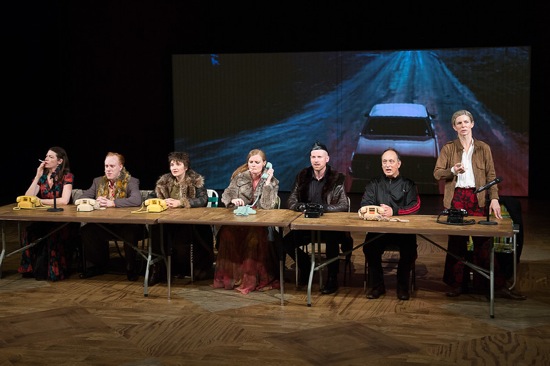
Getting down to business. (L to R): Tymberly Canale, Chris Giarmo, Cynthia Hopkins, Kourtney Rutherford, Aaron Mattocks, Paul Lazar, Elizabeth DeMent. At back: an image from Le Cercle Rouge. Photo: Chris Duggan
At Jacob’s Pillow, the piece takes place in the Doris Duke Theater, whose unpainted wood interior could evoke a huge barn or a high-ceilinged Russian dacha. At the back of the space. broad, vertically hung blinds resemble jail-cell bars when open; closed, they become a screen for projections. The floor has been covered by what resembles a parquet floor (scenery by Joan Howard). The performers relate to objects and attire in a kind of timed dance. They don and fling off a variety of shabby fur coats and hats (those Russian winters). Underneath, some of them wear flowered shirts, pants, or dresses (costumes by Oana Botez). Cigarettes are lit and smoked and brandished. Rotary phones in different colors ring and are answered. Or not. Plastic stemmed glasses are clinked. Pistols are flourished. Costumed stage managers move aluminum-and-plastic garden chairs around and set up tables with the phones on them, as if a conference panel is forthcoming; then that image is broken down.
Of the marvelous performers, four (Tymberly Canale, Chris Giarmo, Cynthia Hopkins, and Kourtney Rutherford) have each worked with Parson and Lazar for close to 20 years; Elizabeth DeMent and Aaron Mattocks closer to 10. All of them (including Lazier) are adept at both speaking and moving, Hopkins is also an accomplished composer-singer, and Giarmo acts as the company’s musical director. In Alan Smithee. . ., they frequently have to change characters—sometimes with barely a pause for breath. At one point, Mattocks as Dr. Zhivago’s vicious army commander Strelnikov (formerly the young rebel “Pasha” Antipov) is barking out an interrogation. That over, he picks up a ringing phone, “Hi honey!” he says delightedly and, relaxing his military stance, lounges on one of the tables. Suddenly, he has become (I think) Flap, the husband of Terms of Endearment’s ill-fated Emma (Debra Wingert) and son-in-law of Aurora Greenway (Shirley MacLaine).
Gender casting is flexible. DeMent pastes on a mustache to help us see her as a male character. Hopkins channels Yuri Zhivago. It’s rare, however, that a role is assumed by the same actor for long. A dialogue between Canale as MacLaine-as-Aurora and Lazar as Jack Nicholson-as-Garrett (her neighbor-and-lover, the former astronaut) takes a maybe a minute (yes, the thrill of space exploration becomes a thing as heady as late-life sex). Often you can’t tell who is who, and I think Lazar and Parson want it that way. You don’t need to know which British actor Giarmo is pretending to be when he speaks in clipped tones at insanely increasing speed. Or exactly what dramatic film moment is re-animated when he unlooses Rutherford’s long blond hair while she stands shivering.
The Russian Revolution and its aftermath, love and premature death, the intricate webs of relationships, mothers and children, a woman torn between two men, a man torn between two women. These and other themes mingle, shift gears, transform, settle down. The directors make you aware of constant underlying turbulence, of shifting emotions, of transformations. Brief very divers scenes overlap or happen almost simultaneously. Joe Levasseur adjusts the lighting to accommodate major shifts. Words are repeated by various performers. Some are succinct but power-packed: “Any idea how much she loved you?”
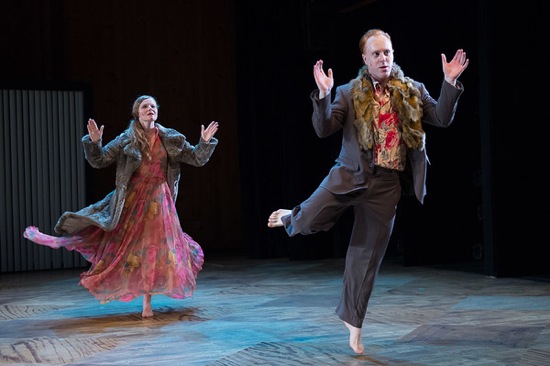
Kourtney Rutherford and Chris Giarmo in Alan Smithee Directed This Play: Triple Feature. Photo Christopher Duggan
Music is heard intermittently, but dancing per se doesn’t play a major part in this (yes, there’s a party with waltzing), but it influences the specific ways in which the characters use their bodies to suggest character. Too, at the beginning of Alan Smithee. . . and at the end, the performers execute a vocabulary of big, jerky stances in unison or counterpoint. I wondered if this was an allusion both to events like presenting arms and to the nature of film. In other words, these could be individual frames from a filmstrip that has lost many of the intervening images.
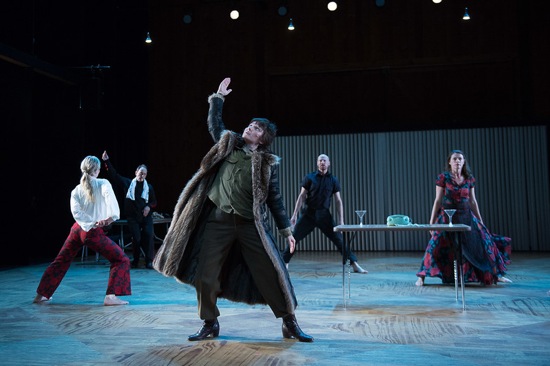
(L to R): Elizabeth DeMent, Paul Lazar, Cynthia Hopkins, Aaron Mattocks, Tymberly Canale. Photo: Christopher Duggan
I don’t sense an overarching structure in Alan Smithee Directed This Play; Triple Feature, the way I have done with others of Parson’s and Lazar’s work. Words and ideas and behavior seem tossed around, scattered and clustered–—the way Russians crowded into the streets and soldiers staggered on through snow. These were, you could say, difficult times—in a family, in the world. Upheaval reigns.
In the end, it doesn’t matter whether or not you’ve seen the films that served as sources. The pair’s bold imagination and their brilliant manipulations of text and images keep you fascinated, even on the edge of your seat. What will happen next? Did anyone see it coming? Does anyone ever?

